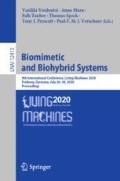Abstract
This paper presents an integrative approach to adaptive structures, which harnesses the scale and strength of natural material actuators such as wood as well as the functional physical programming of material properties enabled by 3D-printing. Passively actuated adaptive systems represent a growing field within architecture, and wood’s innate capacity for hygroscopic responsiveness can be instrumentalized for use as a natural actuator; however, the internal compositions of wood cannot be fully customized. With 3D-printing, it is possible to tailor the internal substructure of physical objects. We introduce a material programming and additive fabrication method for designing macro-scale objects with anisotropic stiffness and elasticity of varying magnitudes using functional patterns, and embedding natural wood actuators into the synthetic 3D-printed structures. In place of electronics and digital control, movement is encoded in the physical material and fabrication logic—demonstrating how self-shaping biohybrid components can emerge from a synergy of natural and synthetic materials.
Access this chapter
Tax calculation will be finalised at checkout
Purchases are for personal use only
References
Boley, J.W., et al.: Shape-shifting structured lattices via multimaterial 4D printing. Proc. Natl. Acad. Sci. 116(42), 20856–20862 (2019). https://doi.org/10.1073/pnas.1908806116
Dow, T.A., Scattergood, R.O.: Mesoscale and microscale manufacturing processes: challenges for materials, fabrication and metrology. In: Proceedings of the ASPE Winter Topical Meeting, vol. 28, pp. 14–19 (2003)
Frey, M., Widner, D., Segmehl, J.S., Casdorff, K., Keplinger, T., Burgert, I.: Delignified and densified cellulose bulk materials with excellent tensile properties for sustainable engineering. ACS Appl. Mater. Interfaces 10(5), 5030–5037 (2018). https://doi.org/10.1021/acsami.7b18646
Grönquist, P., Panchadcharam, P., Wood, D., Menges, A., Rüggeberg, M., Wittel, F.K.: Computational analysis of hygromorphic self-shaping wood gridshell structures. Royal Soc. Open Sci. 7(7), 192210 (2020). https://doi.org/10.1098/rsos.192210
Grönquist, P., et al.: Investigations on densified beech wood for application as a swelling dowel in timber joints. Holzforschung 73(6), 559–568 (2019). https://doi.org/10.1515/hf-2018-0106
Grönquist, P., Wood, D., Hassani, M.M., Wittel, F.K., Menges, A., Rüggeberg, M.: Analysis of hygroscopic self-shaping wood at large scale for curved mass timber structures. Sci. Adv. 5(9), eaax1311 (2019). https://doi.org/10.1126/sciadv.aax1311
La Magna, R., Knippers, J.: Tailoring the bending behaviour of material patterns for the induction of double curvature. In: De Rycke, K., et al. (eds.) Humanizing Digital Reality, pp. 441–452. Springer, Singapore (2018). https://doi.org/10.1007/978-981-10-6611-5_38
Lewis, J.A., Bell, M.A., Busbee, T.A., Minardi, J.E.: Printed three-dimensional (3D) functional part and method of making (2016)
Panetta, J., Zhou, Q., Malomo, L., Pietroni, N., Cignoni, P., Zorin, D.: Elastic textures for additive fabrication. ACM Trans. Graph. 34(4), 1–12 (2015). https://doi.org/10.1145/2766937
Poppinga, S., et al.: Toward a new generation of smart biomimetic actuators for architecture. Adv. Mater. 30(19), e1703653 (2018). https://doi.org/10.1002/adma.201703653
Reichert, S., Menges, A., Correa, D.: Meteorosensitive architecture: biomimetic building skins based on materially embedded and hygroscopically enabled responsiveness. Comput.-Aided Des. 60, 50–69 (2015). https://doi.org/10.1016/j.cad.2014.02.010
Rüggeberg, M., Burgert, I.: Bio-inspired wooden actuators for large scale applications. PloS One 10(3), e0120718 (2015). https://doi.org/10.1371/journal.pone.0120718
Soler, V., Retsin, G., Jimenez Garcia, M.: A generalized approach to non-layered fused filament fabrication. In: Nagakura, T., Tibbits, S., Ibañez, M., Mueller, C. (eds.) DISCIPLINES & DISRUPTION, pp. 562–571. Association for Computer Aided Design in Architecture (ACADIA), Cambridge, MA (2017)
Wood, D., Vailati, C., Menges, A., Rüggeberg, M.: Hygroscopically actuated wood elements for weather responsive and self-forming building parts - facilitating upscaling and complex shape changes. Constr. Build. Mater. 165, 782–791 (2018). https://doi.org/10.1016/j.conbuildmat.2017.12.134
Wood, D.M., Correa, D., Krieg, O.D., Menges, A.: Material computation–4D timber construction: towards building-scale hygroscopic actuated, self-constructing timber surfaces. Int. J. Archit. Comput. 14(1), 49–62 (2016). https://doi.org/10.1177/1478077115625522
Yuan, P.F., Chen, Z., Zhang, L.: Application of discrete system design in robotic 3-D printed shell structure. In: Proceedings of IASS Annual Symposia, vol. 2018, pp. 1–8 (2018)
Acknowledgements
The research was partially supported by the Sino-German Centre for Research Promotion – GZ 1162 – and the German Research Foundation DFG under Germany’s Excellence Strategy – EXC 2120/1 – 390831618. Additionally, this work was tested in a workshop setting at the Digital Futures 2018 conference in Shanghai. The authors especially thank Long Nguyen and Ahmad Razavi for their help in developing the system; we would like to also thank the students who participated in our workshop: Chen Cai, Yunyi Chen, Philipp Farana, Osama Hashem, Mu He, Kecheng Huang, Xiaobai Ji, Zhuoqun Jiang, Zeynab Kaseb, Tomas Vivanco Larrain, Siyu Li, Yige Liu, Jiaxin Nie, Yuchi Shen, Zexin Sun, Xuan Tang, Liu Yang, Zhefan Yu, Fei Yue, Tong Zhang, Qingyu Zhu.
Author information
Authors and Affiliations
Corresponding author
Editor information
Editors and Affiliations
Rights and permissions
Copyright information
© 2020 Springer Nature Switzerland AG
About this paper
Cite this paper
Cheng, T., Wood, D., Wang, X., Yuan, P.F., Menges, A. (2020). Programming Material Intelligence: An Additive Fabrication Strategy for Self-shaping Biohybrid Components. In: Vouloutsi, V., Mura, A., Tauber, F., Speck, T., Prescott, T.J., Verschure, P.F.M.J. (eds) Biomimetic and Biohybrid Systems. Living Machines 2020. Lecture Notes in Computer Science(), vol 12413. Springer, Cham. https://doi.org/10.1007/978-3-030-64313-3_5
Download citation
DOI: https://doi.org/10.1007/978-3-030-64313-3_5
Published:
Publisher Name: Springer, Cham
Print ISBN: 978-3-030-64312-6
Online ISBN: 978-3-030-64313-3
eBook Packages: Computer ScienceComputer Science (R0)

